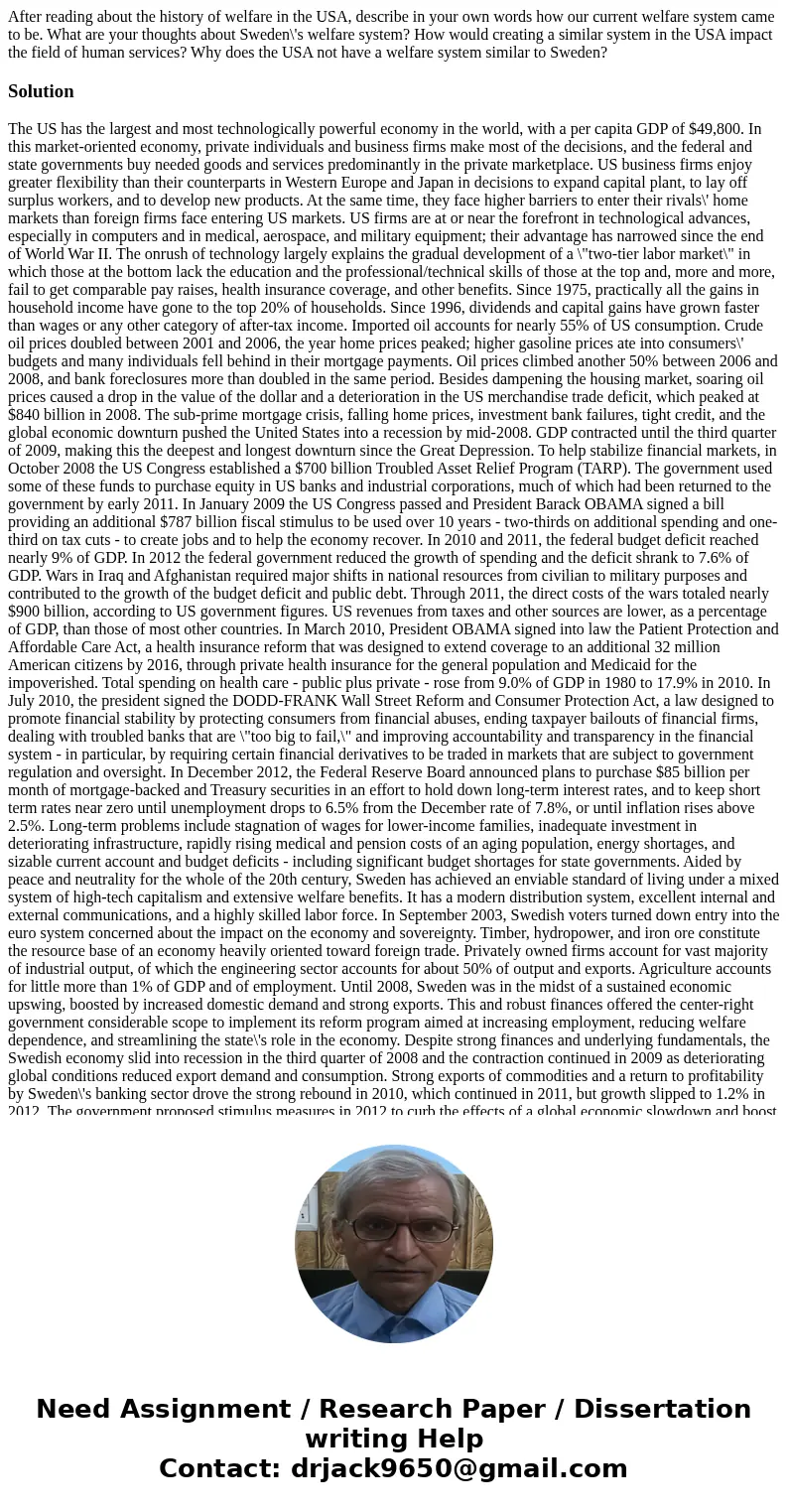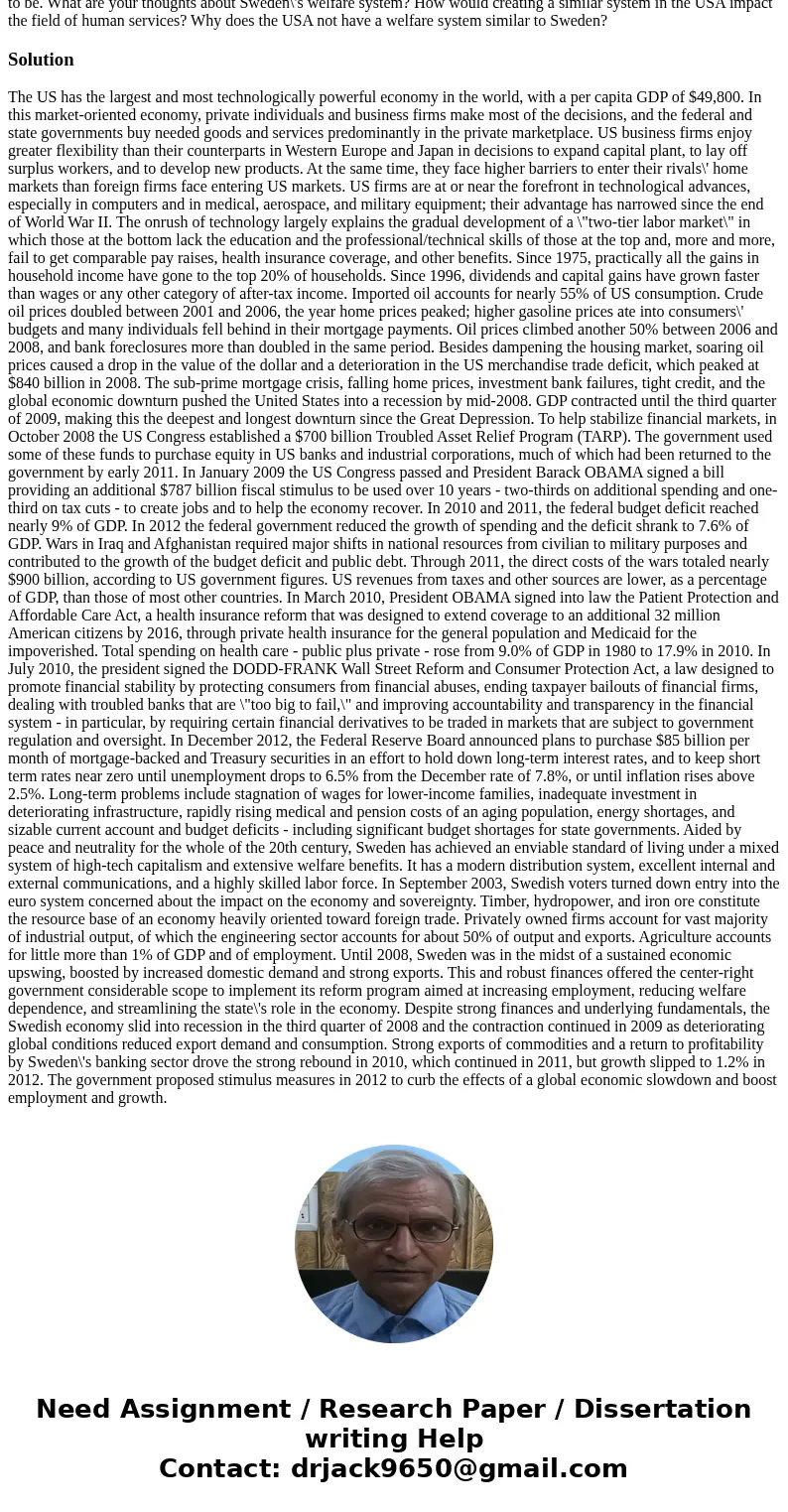After reading about the history of welfare in the USA descri
After reading about the history of welfare in the USA, describe in your own words how our current welfare system came to be. What are your thoughts about Sweden\'s welfare system? How would creating a similar system in the USA impact the field of human services? Why does the USA not have a welfare system similar to Sweden?
Solution
The US has the largest and most technologically powerful economy in the world, with a per capita GDP of $49,800. In this market-oriented economy, private individuals and business firms make most of the decisions, and the federal and state governments buy needed goods and services predominantly in the private marketplace. US business firms enjoy greater flexibility than their counterparts in Western Europe and Japan in decisions to expand capital plant, to lay off surplus workers, and to develop new products. At the same time, they face higher barriers to enter their rivals\' home markets than foreign firms face entering US markets. US firms are at or near the forefront in technological advances, especially in computers and in medical, aerospace, and military equipment; their advantage has narrowed since the end of World War II. The onrush of technology largely explains the gradual development of a \"two-tier labor market\" in which those at the bottom lack the education and the professional/technical skills of those at the top and, more and more, fail to get comparable pay raises, health insurance coverage, and other benefits. Since 1975, practically all the gains in household income have gone to the top 20% of households. Since 1996, dividends and capital gains have grown faster than wages or any other category of after-tax income. Imported oil accounts for nearly 55% of US consumption. Crude oil prices doubled between 2001 and 2006, the year home prices peaked; higher gasoline prices ate into consumers\' budgets and many individuals fell behind in their mortgage payments. Oil prices climbed another 50% between 2006 and 2008, and bank foreclosures more than doubled in the same period. Besides dampening the housing market, soaring oil prices caused a drop in the value of the dollar and a deterioration in the US merchandise trade deficit, which peaked at $840 billion in 2008. The sub-prime mortgage crisis, falling home prices, investment bank failures, tight credit, and the global economic downturn pushed the United States into a recession by mid-2008. GDP contracted until the third quarter of 2009, making this the deepest and longest downturn since the Great Depression. To help stabilize financial markets, in October 2008 the US Congress established a $700 billion Troubled Asset Relief Program (TARP). The government used some of these funds to purchase equity in US banks and industrial corporations, much of which had been returned to the government by early 2011. In January 2009 the US Congress passed and President Barack OBAMA signed a bill providing an additional $787 billion fiscal stimulus to be used over 10 years - two-thirds on additional spending and one-third on tax cuts - to create jobs and to help the economy recover. In 2010 and 2011, the federal budget deficit reached nearly 9% of GDP. In 2012 the federal government reduced the growth of spending and the deficit shrank to 7.6% of GDP. Wars in Iraq and Afghanistan required major shifts in national resources from civilian to military purposes and contributed to the growth of the budget deficit and public debt. Through 2011, the direct costs of the wars totaled nearly $900 billion, according to US government figures. US revenues from taxes and other sources are lower, as a percentage of GDP, than those of most other countries. In March 2010, President OBAMA signed into law the Patient Protection and Affordable Care Act, a health insurance reform that was designed to extend coverage to an additional 32 million American citizens by 2016, through private health insurance for the general population and Medicaid for the impoverished. Total spending on health care - public plus private - rose from 9.0% of GDP in 1980 to 17.9% in 2010. In July 2010, the president signed the DODD-FRANK Wall Street Reform and Consumer Protection Act, a law designed to promote financial stability by protecting consumers from financial abuses, ending taxpayer bailouts of financial firms, dealing with troubled banks that are \"too big to fail,\" and improving accountability and transparency in the financial system - in particular, by requiring certain financial derivatives to be traded in markets that are subject to government regulation and oversight. In December 2012, the Federal Reserve Board announced plans to purchase $85 billion per month of mortgage-backed and Treasury securities in an effort to hold down long-term interest rates, and to keep short term rates near zero until unemployment drops to 6.5% from the December rate of 7.8%, or until inflation rises above 2.5%. Long-term problems include stagnation of wages for lower-income families, inadequate investment in deteriorating infrastructure, rapidly rising medical and pension costs of an aging population, energy shortages, and sizable current account and budget deficits - including significant budget shortages for state governments. Aided by peace and neutrality for the whole of the 20th century, Sweden has achieved an enviable standard of living under a mixed system of high-tech capitalism and extensive welfare benefits. It has a modern distribution system, excellent internal and external communications, and a highly skilled labor force. In September 2003, Swedish voters turned down entry into the euro system concerned about the impact on the economy and sovereignty. Timber, hydropower, and iron ore constitute the resource base of an economy heavily oriented toward foreign trade. Privately owned firms account for vast majority of industrial output, of which the engineering sector accounts for about 50% of output and exports. Agriculture accounts for little more than 1% of GDP and of employment. Until 2008, Sweden was in the midst of a sustained economic upswing, boosted by increased domestic demand and strong exports. This and robust finances offered the center-right government considerable scope to implement its reform program aimed at increasing employment, reducing welfare dependence, and streamlining the state\'s role in the economy. Despite strong finances and underlying fundamentals, the Swedish economy slid into recession in the third quarter of 2008 and the contraction continued in 2009 as deteriorating global conditions reduced export demand and consumption. Strong exports of commodities and a return to profitability by Sweden\'s banking sector drove the strong rebound in 2010, which continued in 2011, but growth slipped to 1.2% in 2012. The government proposed stimulus measures in 2012 to curb the effects of a global economic slowdown and boost employment and growth.

 Homework Sourse
Homework Sourse